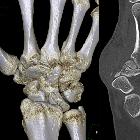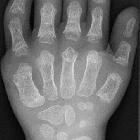Karpale Koalition























Carpal coalition refers to failure of separation of two or more carpal bones, and although the most commonly involved bones are the lunate and triquetrum, most combinations of adjacent bones can be found to be coalesced.
Terminology
Carpal fusion is a misnomer, as it is the failure of normal segmentation of carpal mesenchyme that results in the anomaly . Carpal coalition is less contentious as its definition means a connection between two bones, it says nothing about how they came to be connected .
Epidemiology
The estimated prevalence is ~0.1% in Caucasian Americans and ~1.5% in African Americans, and it tends to affect women more commonly .
Associations
There are several associated conditions, especially with multiple coalitions:
Pathology
As with tarsal coalition, congenital carpal coalition can either be osseous (synostosis), cartilaginous (synchondrosis), or fibrous (syndesmosis).
Etiology
Non-syndromic congenital carpal coalition is transmitted via a Mendelian inheritance pattern. Acquired intercarpal fusion can either be a consequence of an inflammatory arthropathy (e.g. rheumatoid arthritis, psoriatic arthritis, reactive arthritis) or injury, or due to intentional surgical arthrodesis.
Types
The two most common types are:
- lunotriquetral coalition: much more common than all other types combined
- capitohamate coalition
Siehe auch:
- Carpal boss
- Tarsale Koalition
- arthritisches Os carpale
- Turner-Syndrom
- Arthrogryposis multiplex congenita
- Synostose
- Ellis-van-Creveld-Syndrom
- Os carpale
- Symphalangismus
- Lunotriquetrale Koalition
- angeborene Handfehlbildungen
- Juvenile idiopathische Arthritis
- Holt-Oram-Syndrom
- capito-hamate coalition
- Fusion von Os capitatum und Os trapezoideum
- Handwurzelknochen
- spondylocarpotarsal synostosis syndrome
- angeborenes Os carpale
und weiter:

 Assoziationen und Differentialdiagnosen zu Karpale Koalition:
Assoziationen und Differentialdiagnosen zu Karpale Koalition:










